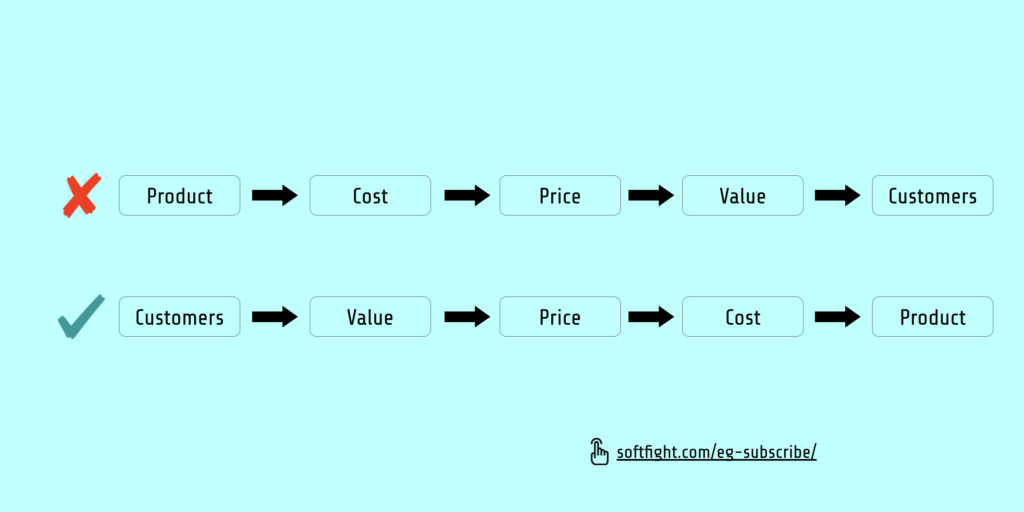I’ve heard of many startups working on their product for 6 or 12 months, but have not yet calculated what the prices for that product will be.
If I were to be diplomatic, I would say this is not an optimal situation to be in for the founders of those startups (or their team members, or their investors).
If I were to be honest and direct, I would say those founders are being reckless.
There are many arguments that can be cited as reasons for not thinking about pricing early on.
“We don’t know how much it will cost us to develop and deliver the product.”
“Our product is so innovative and special that we can’t talk about it with potential customers, we have to show it works. So we need to build it first.”
“We don’t know who will buy our product.”
“We don’t care about profits, we only care about growth, so we don’t need to think about pricing.”
“We don’t have historical data for this type of product for these types of customers, so we can’t make forecasts.”
For all arguments like these, I have learned that there are estimates, “exactimates” and “guesstimates”.
Exactimates are great if you have them, but most of the time we don’t know how much something took to develop or what are the exact costs even after the fact. So it’s not even worth trying to work with them.
If we think we don’t have enough data, information or experience to do estimates, then we have to rely on guesstimates. Because guesstimates are always better than no estimates at all.
Let’s take an example of a hypothetical technology startup and see what we need to calculate prices and make a business plan.
What: Software startup.
Who: 2 Co-founders, 1 with technical expertise, 1 with business experience.
Timeline: Initial phases of thinking about the product. Looking to make a forecast of costs and revenues for the first 12 months after launching the first version (Minimum Viable Product).
Economical Value Model
The first step you can take is estimate how much value you will create for your customers.
Starting from the basic idea about the product, identify some of the problems the product will solve and quantify value created in monetary terms.
Put a dollars or euros amount, based on how much you think your customers will save in costs by using your solution, how much extra revenues they can make or what value they would assign to managing risks better.
If you know how much value you create, you can already estimate how much value you can realistically capture back (typically, between 10 and 30%). If your customers will achieve savings of 10.000 EUR per year, you should not price your product below 1.000 EUR per year and it’s likely that you will not be able to charge more than 3.000 EUR per year.
Competitive Landscape
Once you have identified types of customers with problems that you think you can solve with a product, you can map out the competitive landscape, to make some estimations of efforts and costs to get the product to be used and paid for by customers.
You can make a go-to-market plan by looking at the different customer segments and what they are currently doing to solve those problems (could be nothing, self-service solutions, working with external suppliers, alternative products from other areas, using products similar to the one you are building, etc.).
Based on the channels you choose, you should be able to make some forecasts of top of the funnel volumes, conversion rates at different price points and cost of sales associated with each potential contract that you would get.
You might need to run some market research surveys to get data on customer preferences and willingness to pay. Both MaxDiff and Van Westendorp Price Sensitivity Meter are rather straightforward tools that can be used in a cost-effective way and for which you don’t need to have a live product to demonstrate. You just need a description of the product.
Total Costs
You now have most of the data you need to build the complete forecast, by adding the expected cost of product development and delivery.
Since we are talking about a software company, most of your costs will be salaries, taxes and the admin overhead for the team.
Lines of code written so far: 0
If you read back the last few paragraphs you will notice that there was no actual software development work involved. You can do all that without writing a single line of code.
At most, if you really want to be visual in your approach, you could use a clickable prototype built with a designer. That’s all you need.

WHAT THIS MEANS FOR YOU
If I were building a product that is at risk of not being economically viable, I would prefer to know that earlier rather than later.
Which means I would calculate prices to be able to make forecasts of costs and revenues as early as possible.
You don’t need to write any single line of code to be able to make detailed calculations of the economic viability of a technology based startup.

